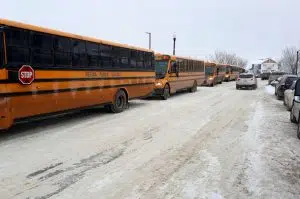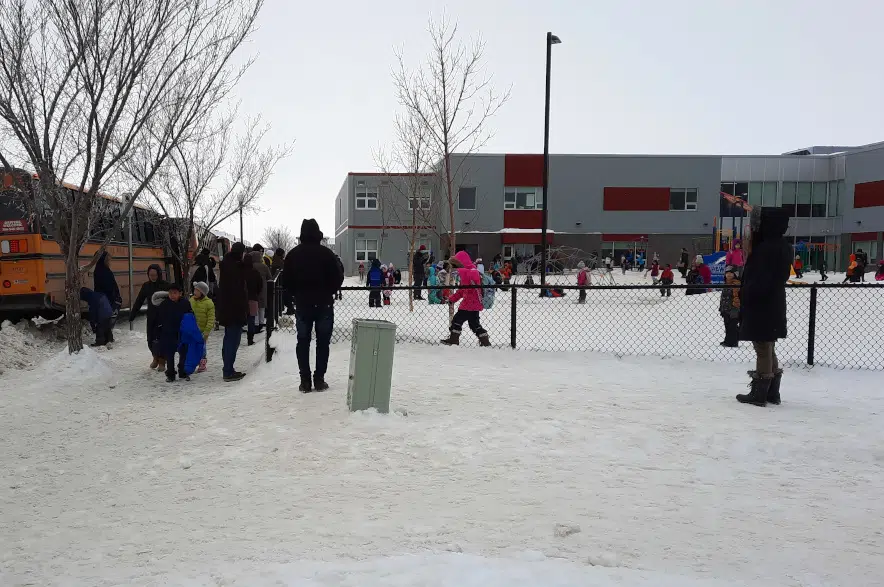For the half hour between 3:15 and 3:45 p.m., the streets around Harbour Landing’s joint-use school are absolutely awash in children and the narrow roads are packed end to end with parents in SUVs waiting to pick up their kids.
It’s a steady stream out the doors — first one school, then the other. The situation poses safety issues, according to a representative from one school division, because the schools are overcrowded and there are just too many kids.
Classrooms are bursting at the seams with children, librarians are teaching in stairwells, and safety concerns are rising – and with the prospect of relief far off, it’s only set to get worse.
The schools are Harbour Landing School on the Regina Public Schools side, and St. Kateri Tekakwitha School of the Regina Catholic School Division.
The schools opened in 2017 at, or near, their capacity. The public side was built for 650 students, but this fall, there were about 1,000 students enrolled — and projections are calling for 1,500 by 2027.
“Our music room is now a double classroom and our science labs are now classrooms. Literally, there is no physical space left in the building to place another classroom,” explained Kathleen Eisler, the chair of Harbour Landing School’s community council.
Eisler also has children who attend the school.
She said kids don’t get the recommended amount of gym time, they can’t have a full assembly with the entire school in attendance, and the music teacher is teaching off of a cart.
“The library is a spot at the bottom of the stairs in which the librarian has to teach while there’s everyone passing by,” said Eisler.
The Catholic side currently has about 680 students and has hit its limit for portable classrooms that could be added to make room.
During a city planning committee meeting in October 2021, Catholic division representatives said the school campus is “significantly overcrowded” and there are safety issues during drop-off and pick-up times, during recess, and during the school day due to the sheer volume of students.
Sean Chase, director of education for the Regina Catholic School Division, called more students a “good-news story” but also said it’s challenging to find space for them. St. Kateri is having to use break-out learning spaces as classrooms, having to put up temporary walls to create classroom space.
“The advantage of the design of those beautiful schools like St. Kateri and the other P3 schools is that, compared to the vast majority of the rest of our sites, there are quite expansive, wide-open spaces,” Chase said.
Both divisions have made wider changes to help – the Catholic division changed its school boundaries in recent years to divert some children to other schools, while the public division moved its French immersion program out of Harbour Landing in 2020 to a nearby school to make room.
Eisler said both schools combined are nearing the legal load capacity for a building, which is separate from classroom overcrowding numbers. That’s why she’s been informed the schools can’t have events and invite the public or parents inside if the other school is in session.
“It would be unsafe. There aren’t enough egress points for the number of people that would be in the building if we were to, let’s say, have a Remembrance Day ceremony in which you’re going to invite parents in to be a part of the assembly. That cannot happen,” said Eisler.
Regina Public Schools had a new school for the Harbour Landing neighbourhood in its requests from the provincial government in the 2018, 2019 and 2020 budget cycles. Then in the 2020-21 provincial budget, a new joint-use school for the area was announced.
At an event in September 2020, then-Education Minister Gord Wyant said the government hoped to have shovels in the ground in 2021, but it’s almost 2 1/2 years later and a location still hasn’t been chosen for the building.

Five school buses line the street outside Harbour Landing School at pickup time. (Lisa Schick/980 CJME)
This wasn’t a gradual problem — the school was overcrowded from the beginning.
In 2017 when the schools opened, they were at or over capacity already and part of the reason is “densification” – the process of making a neighbourhood more dense with people and living space.
When the Harbour Landing community plan was first put together, the neighbourhood was much less dense than it is now. But as it was built out, Evan Hunchak, general manager of land development in Regina for Dream Developments, said the market changed and people were able to afford less house.
“A 50-foot lot that would be quite typical back in the ’90s and early 2000s just became too expensive for people to build a large single-family home on and affordability just erodes over time, so we start to see smaller single-family homes that would be maybe like you’d find in Cathedral or Lakeview,” said Hunchak.
Now, the density in Harbour Landing is about 50 people per hectare, which is currently the minimum population density for any new neighbourhoods in Regina.
The original population for the neighbourhood was going to be 9,500 people with about 10 per cent believed to be kids, but with the densification, the population increased and was at 13,100 as of fall 2021.
The densification plans went through the city and were circulated to the school divisions but no red flags were raised about a possible need for another school.
“The city was doing their best to give us information in the schools, but the reality is it’s also the first neighbourhood of its kind in terms of density in our city. So we had no experience in either of the school divisions in terms of what that would actually look like, we did our best to do projections based upon experience and information that had been given to us,” said Chase.
During meetings about this, there was a lot of talk about the speed with which Harbour Landing filled in.
Chase said the division didn’t anticipate the migration within the city – families who left other areas to move to Harbour Landing. He called it unprecedented, saying within the first two months of St. Kateri opening, it had a student from every other school in the city.
“I think you had a perfect storm of a new development, of all of us – both the city and the school divisions – trying to understand how that would look when it was something brand new. And in the end, (it was) the good-news story, lots of kids and a very vibrant school campus … but beyond that, also a very, very busy place,” said Chase.
Sandra Masters wasn’t mayor when the original planning was done, but she explained that over the 10 years the neighbourhood was changing and getting more and more dense, no one was tracking how many kids there would be.
“We continued to add to it over the years and then didn’t actually carry that through on planning, even the lift station … even from the perspective of ‘Do we have enough capacity within the infrastructure that was build to accommodate this additional growth?’ ” said Masters.
The mayor asked several pointed questions on that subject during the city council meeting in October 2021.
Originally, Hunchak said the Harbour Landing community plan did include a second school.
“At the time, the regulator – being the municipality and the school boards – decided it wasn’t needed so that second site that was originally planned for was removed,” said Hunchak.
At the current neighbourhood density targets, Hunchak said Dream aims for a school site for every 320 acres. Right now, Harbour Landing is about 800 acres in size.
“It’s not a surprise that a second school is needed,” said Hunchak.
With all possible classroom space full in the school and the maximum number of portable classrooms on the building, a new school is what’s needed.
Part 2 talks about the plan at a standstill and the political finagling slowing things down.











